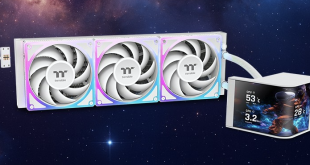To test all CPU coolers, we devised an easily repeatable test with no variables other than the coolers themselves. This ensures that figures from every cooler we test are comparable with each other.
Test rig
Using an open-air test bench, we deploy a Ryzen 7 1700 plugged into a Gigabyte Aorus AX370 Gaming 5 motherboard. Alongside this is 16GB of 2666MHz PNY Anarchy DDR4, as well as a 120GB OCZ Trion 150 SSD. Powering everything is a Seasonic Prime 650W Platinum PSU.
The test process
Testing coolers involves taking a total of 4 temperature readings per cooler. First, we measure the idle temperature of the R7 1700 at stock speeds (3.2GHz across all cores), before measuring its temperature under load at stock speeds. Next, we overclock the CPU to 3.9GHz using a 1.4 Vcore, ensuring greater heat output. In its overclocked state we then measure the idle and load temperatures of the CPU again. The figures we present are temperature deltas – meaning we take each temperature reading and minus the ambient temperature from it. This allows us to test in an environment that is not temperature-controlled.
Where possible, each cooler’s fans are plugged directly into the motherboard using the CPU_Fan or CPU_Opt headers. Some AIOs, however, ship with their own fan controllers or PWM hubs. If we are unable to plug the fans directly into the motherboard, it is specified in the performance section of the review.
An idle reading comes from leaving Windows on the desktop for 15 minutes. A load reading comes from running Prime95’s (version 26.6) Small FFTs test for 15 minutes – enough time for temperatures to plateau. We get our temperature readings using HWINFO64.
Noise output
Unfortunately I am unable to properly measure the sound output of CPU coolers using a digital sound meter. This is because I am based alongside a busy road (with high ambient noise levels). Using a sound meter is, as such, not possible as there are variables out of my control. However, I will try my best to subjectively describe the noise output in a helpful manner.
 KitGuru KitGuru.net – Tech News | Hardware News | Hardware Reviews | IOS | Mobile | Gaming | Graphics Cards
KitGuru KitGuru.net – Tech News | Hardware News | Hardware Reviews | IOS | Mobile | Gaming | Graphics Cards



Thx, for the Scythe Muggen PCGH Review. Waiting a long time for a review of the pcgh version.
Why not the CM MasterLiquid 240? It’s the same packaging, pump, braided tubing just with the larger radiator. I picked it up around a month ago and was surprised to find the AM4 kit inside, surely a first. It cost me £69.99 and I’m sure it would have walked away with an award.
Where’s the Arctic Liquid Freezer 240, the best value in a Ryzen cooler right now?
Over all, this isnt a good look for the stock coolers relative, and surely performance & life sapping, absolute numbers.
I saw no mention of cooling chipsets, which could get seriously warm with onboard sata raid arrays etc.
I think i would pay a premium for a multi heatsink unit.
A simple Cheap ass suggestion.
Contrive a $20 12v tire pump, jetting air via the hose onto the stock wraith heatsink fins at the base via an inserted ball inflating nozzle e.g.
a fan on the compressor head & BoyleS law, should mean the air jet is quite frigid (& pulsing, which may help).
u could even contrive a reserve “tank”/extra cooling, using any tire.
Two questions about your idea; cost? noise?
Tyre type compressors are generally noisy and move little volume of air
It wouldn’t do .much to cool itema
Just wonking.
Cost is cheap as i said, noisy if close – yes.
Quiet ~modern fridge compressors I hear, use “free piston” pumps, a concept i just love.
The mechanically unconnected piston, is reciprocated magnetically.
Yep, not much volume, but precisely targeted and frigid. u already have volume from the existing fan which remains, but as we see, it has its limits..
I also like the idea of two opposing jets (~as per prev post), directed at the hottest, base center of the processor heatsink – create a mini hi pressure, pulsing cyclone there.
The notion is not “always on”, its a turbo mode if needed – like gaming. If CPU cooler, ryzen auto overclocks – simple.
with a tank, as described, it could run quiet for some hours – borrow a colleagues spare tire & deflate that – he wont mind 🙂
i wish they tested the stock wraith cooler.